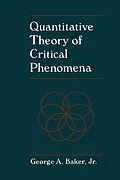Quantitative Theory of Critical Phenomena details in a self-contained manner the most popular and extensively practiced methods for the quantitative study of critical phenomena. The text is divided into three parts. Part I deals with the general theory of critical phenomena - its thermodynamic aspects, statistical mechanical framework, classical model, and inequalities. Part II tackles the combinatorial theory of series generation. Part III covers the quantitative analysis of series expansions, which includes topics such as the complex variable theory, the algebraic aspects and numerical evaluation of Padé approximants, and special continuation methods. The book is recommended for mathematicians and physicists who would like to know more about critical phenomena, its theories, and the methods for its quantitative study.
Inhalt
Illustrations
Preface
Part I. General Theory of Critical Phenomena
Chapter 1. Thermodynamic Aspects
a. Phase Diagrams
b. Thermodynamic Potentials
c. Behavior at Critical Points
d. Stability and Convexity
e. Thermodynamic Inequalities
Chapter 2. Statistical Mechanical Framework
a. Regular Assemblies
b. One Dimensional Assemblies
d. Two-Point Correlation Functions
Chapter 3. Classical Models
a. Mean Field Theory
b. Ornstein-Zernike Theory of the Two Point Correlation Function
c. The Gaussian Model
d. The Spherical Model
e. Landau-Ginsburg Theory
Chapter 4. Inequalities
a. Correlation Function Inequalities
b. The Yang-Lee Theorem
c. Application of the Inequalities to the Critical Region
Chapter 5. Two dimensional Ising Model
Chapter 6. General Approaches
a. Series Expansions
b. Homogeneity Theory
c. Scaling Theory
d. Renormalization Group Theory
e. The E-Expansion
f. Hierarchical Model
g. Implementation of Renormalization Group Ideas by Means of Field Theory Methods
h. Universality
i. Conformal Invariance
Part II. Combinatorial Theory of Series Generation
Chapter 7. Elementary combinatorics
a. Preliminaries
b. Basic Cluster Theorem
Chapter 8. Finite Cluster Method
Chapter 9. Star Graph Expansion
Chapter 10. Linked Cluster Expansion
Chapter 11. Expansion about the Gaussian (or Spherical) Model
a. Coupling Constant Expansion
b. 1/n -expansion
Chapter 12. Numerical Computation of Combinatorics
Part III. Quantitative Analysis of Series Expansions
Chapter 13. Complex Variable Theory
a. Preliminaries
b. Exact Analytic Continuation
c. Riemann's Monodromy Theorem
d. Carleman's Criterion
Chapter 14. Padé Approximants, Algebraic Aspects
a. Approximate Analytic Continuation
b. Padé Table
c. Invariance Theorems
d. Bigradients
e. Continued Fractions
f. Some Exactly Known Padé Approximants
Chapter 15. Numerical Evaluation of Padé Approximants
a. Requirements
b. Gaussian Elimination
c. Viskovatov-Butheel Algorithm
d. Recursion Methods
Chapter 16. Padé Approximants to Series of Stieltjes
a. Yang-Lee Theorem and Series of Stieltjes
b. Characterization of Series of Stieltjes
c. Location of Poles of the Padé Approximant
d. Padé Bounds on the Function
e. Convergence Theory
Chapter 17. Padé Approximants, General Convergence Theory
a. Counter-Examples
b. Faithfulness Theorem
c. Error Formula
d. Point Wise Convergence
e. Convergence Almost Everywhere
Chapter 18. Interpretation of Padé Approximants
a. Representation of Singularity Structures
b. Apparent Error Estimation
Chapter 19. Integral Approximant Theory
a. Definition of Integral Approximants
b. Invariance Properties
c. Separation Property
d. Convergence Properties
e. Numerical Examples
Chapter 20. Special Continuation Methods
a. Ratio Methods
b. Gammel's Emphasis Method
c. Baker-Gammel Approximants
d. Darboux's Theorems Methods
e. Uniformization Transformation Methods
Chapter 21. Series Analysis for Critical Properties
a. Monodromic Dimensions 1, High- and Low-Temperature Series Estimates for Critical Points, Exponents, etc.
b. Series Estimates for Higher Monodromic Dimensions
c. Renormalization Group Series Estimates for Critical Indices
References
Index
